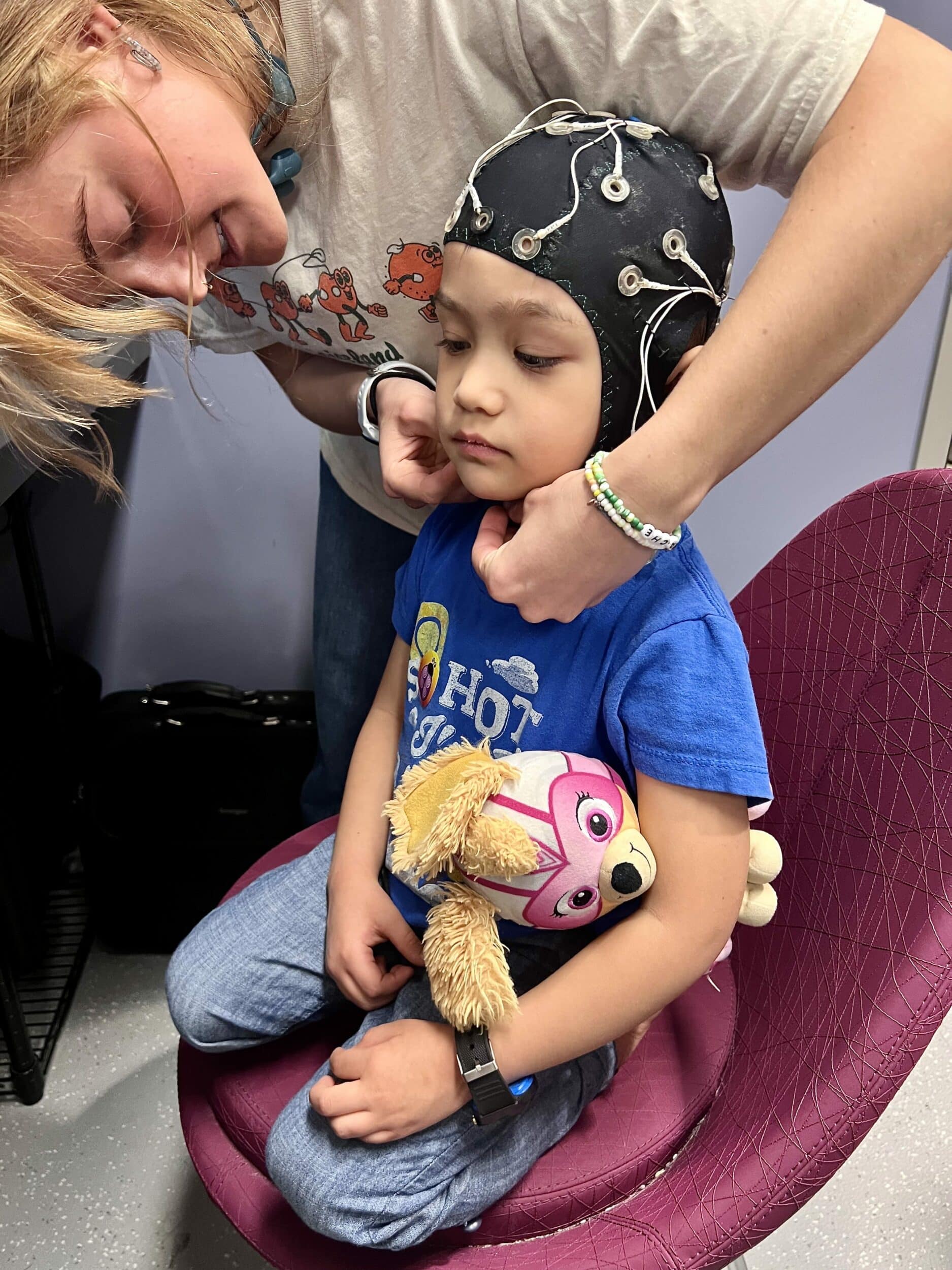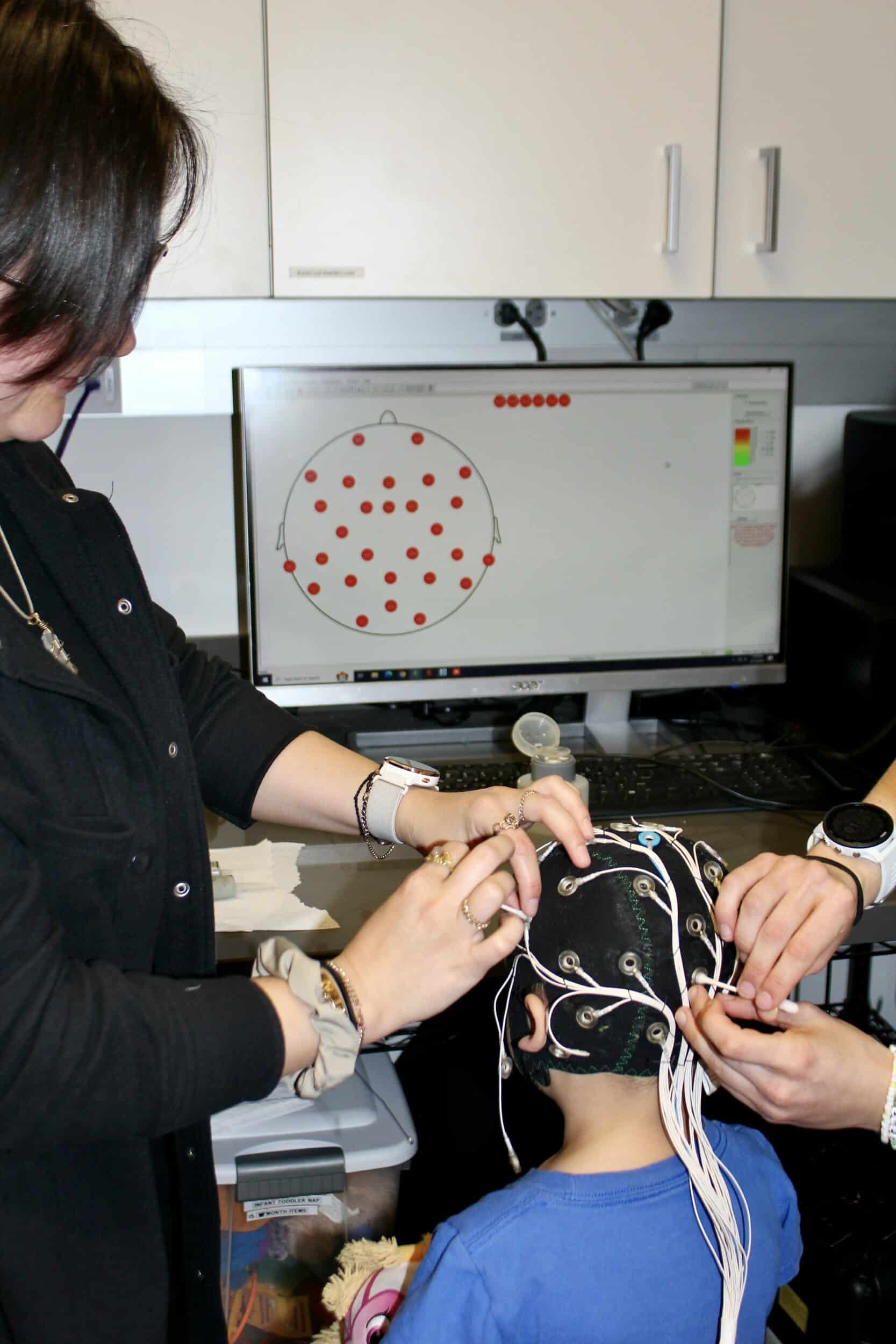By Sree Roy
“I need a nap.”
My 2.5-year-old says this with her arms raised, willing me to pick her up, wipe the sticky remnants of lunch off her face, and place her in a blackout-curtain darkened bedroom for her mid-day nap.
What my toddler doesn’t know—but I do after interviewing neuroscientist Rebecca M. C. Spencer, PhD—is the spot-on choice of the verb “need.” As it turns out, children who habitually nap need daytime sleep to consolidate their memories, just as adults need adequate nighttime sleep to consolidate memories in their brains, according to research by Spencer and her co-investigators. What’s more, for regular nappers, the negative effects on memory caused by skipping mid-day sleep can’t be reversed simply by adding to their overnight sleep time.
As the principal investigator of the SomneuroLab at the University of Massachusetts Amherst, Spencer asks questions with importance not only to parents like myself but also with larger implications for society. What is the function of naps? Why do children outgrow them?
As her research finds answers, preschool policies, clinical guidelines for pediatricians, and learning strategies for children with signs of neurodiversity may ultimately become science-informed.
“Some preschools take 4-year-olds with learning delays out for learning interventions while the rest of the class is napping. But we’re finding that, no, these children need their nap time,” Spencer says. For example, Spencer has found that when the sleep time is extended for toddlers and preschoolers with early symptoms of attention deficit hyperactivity disorder (ADHD), their ADHD-like symptoms improve “versus when we increase the sleep of a typically developing kid, more sleep doesn’t do anything to their behavioral measures,” Spencer says.
“Children with ADHD symptoms probably have a greater sleep need, which is consistent with findings that hyperactivity is a counterintuitive reaction in children to sleep deprivation….Naps could be a way to help those kids meet their high sleep needs.”
Early Study on Naps and Learning
In 2013, when Spencer, Laura Kurdziel, PhD, and Kasey Duclos published a paper about whether naps benefit memory in preschoolers, it burst the myth that young children’s naps consisted of light sleep only. Spencer says, “Naps contain deep, rich sleep. We can now say they are beneficial for memory. This was new information.”
The study provided compelling evidence that classroom naps support learning in preschoolers by enhancing memories acquired earlier in the day. In-lab polysomnography (PSG) of naps supported a role of sleep spindles in memory performance.
“When we looked at that data closely, yes we saw that naps were beneficial,” Spencer says. “But if we looked at the difference between habitually and non-habitually napping kids, it wasn’t so much about the benefits. The difference was actually in how detrimental it was to keep a habitual napper awake.”
Spencer hypothesized that the need for a nap is related to brain development. “We pointed toward the hippocampus because of how sleep is intertwined with learning,” she says.
Hippocampal Development
Around the same time, developmental child psychologist Tracy Riggins, PhD, was wondering what could underlie the large difference in hippocampal development in children between the ages of 3 and 5 years. Could it be sleep?
At a colleague’s recommendation, Riggins attended a talk Spencer gave at a Society for Research in Child Development conference. “And I thought, ‘This is exactly what I need to know about sleep and memory,’” Riggins says. She and Spencer went to dinner, which sparked a lasting research collaboration. “From that connection made at a conference, I added a measure of sleep. We started doing grants together: sleep, memory, and brain development,” Riggins says.
Their results suggest that when the hippocampus is immature, memory consolidation must take place frequently. If the hippocampus is like a bucket, at first, it is a small one. The nap lets the bucket offload its contents mid-day, so it can fill up again before fully processing everything overnight (when more sleep cycles take place). “During early childhood, your bucket gets bigger, and you can just consolidate it at night,” Riggins says.
They are testing whether the nap transition or the hippocampus development occurs first. “We predict the bucket [the hippocampus] gets bigger first. We will see,” Riggins says.
Practical Methods for Pediatric Sleep and Brain Research
As a methods paper published by Riggins, Spencer, and co-investigators notes, “The main limitation of PSG is the time it takes to apply the electrodes. In children this can be especially important as they are prone to boredom and limited attention.”
Spencer and Riggins have benefited from sharing their research methods. “It’s a huge thing to teach another lab your method,” Riggins says. “Even the method of how to assess polysomnography, we do that in my lab now because of her.”
To measure sleep in children, Spencer at times uses in-lab and at-home PSG, actigraphy, and parent self-reports within a single study.
She currently uses the Natus Embletta MPR PSG Sleep Study System. The 12-electrode version is used in homes (a sleep tech sets it up in person), and higher-density EEG caps are used in the sleep lab.
For actigraphy, she uses the Activinsights’ GENEActiv, worn on either the wrist or, in the case of infants, the ankle. “We buy them colorful bands to make them more appealing,” Spencer says.
When the children are on break from the actigraph, they switch to the consumer wearable Fitbit Inspire. “It’s an exploratory aid to pick up some nap transitions,” Spencer says.
To measure brain maturation, Riggins too has developed practical ways to get children to cooperate. For one, her magnetic resonance imaging (MRI) scanners are equipped with screens. Children watch cartoons while having their brains scanned. They also leave with a “prize”—their bran scan ironed into a T-shirt.
“I want to convince as many researchers as I can that we can do MRIs in young children,” Riggins says.
Spencer and Riggins’ latest project, funded with $6.7 million in grants from the National Institutes of Health (NIH), includes MRI scans for preschoolers. Riggins says of Spencer, “I hope she gets bitten by the brain development work bug and continues to do brain scans in her work.”
Longitudinal Research on Sleep & Brain Development
So far, Spencer and Riggins have used cross-sectional approaches, meaning their studies analyze sleep and brain data at one time point. The NIH funding lets them take their research to the next level: longitudinal studies.
The research team is recruiting 180 children ages 3 to 5 years. The researchers will track their brain development, memory performance, and nap status over one year at three checkpoints.
“Brain development is not a linear process,” Spencer says. “It takes place across varying time curves across kids. This longitudinal data set will show us: Does the hippocampus develop in advance of nap transitions, or do nap transitions cause hippocampal development?”
A parallel longitudinal study on nap transitions and memory will be done with infants—who will have their sleep and memory studied at 9, 12, and 15 months. “We think a similar change is happening in infants when they go from a twice-a-day to a once-a-day nap. We predict this is also representing a shift in hippocampal development,” Spencer says.
Babies’ naps remain a great mystery. Spencer asks, “Nobody has compared a morning nap and an afternoon nap. Are they physiologically different?”
Sleep Across the Lifespan
The ideal longitudinal study on sleep, memory, and brain development would be observing people starting as children and continuing through their entire lives until death, mulls Lauren N. Whitehurst, PhD, an associate professor at the University of Kentucky who studies how neural changes during sleep support cognitive function in adults. For now, Whitehurst’s research in adults both takes the baton and hands it back to scientists like Spencer who run studies on children. (Spencer does also run some studies on adults at the SomneuroLab.)
Sleep and memory research in children and adults inform each other. “Slow wave sleep in particular has really been highlighted nicely in some of the children’s work. It has informed some of the ways in which we ask questions when we study adults,” Whitehurst says.
The bidirectionality emphasizes a lifespan approach. “It is so important that we consider sleep across the lifespan,” Whitehurst says. “Both to understand how the brain changes due to sleep and, the reverse, how brain changes inform sleep.”
Napping Recommendations
So many parents, including me, want to know: When will my child be OK with losing her afternoon sleep?
Spencer’s work could lead to a hippocampal maturation screening tool of some sort, which could help predict when an individual child is ready for a nap transition.
More critically for society, I hope her work will lead to formal evidence-based guidelines on children’s nap timing, length, and transitions. This could influence preschool schedules and early childhood intervention plans.
In the meantime, the work of Spencer and her collaborators is building the case that skipping mid-day sleep causes catastrophic forgetfulness in children who habitually nap—and is starting to explain the mechanisms behind it. That just nudges me, as a mom, to listen to my 2.5-year-old emphatically explain what she needs–at least when it comes to sleep.
Photo credit: UMass Amherst








Leave a Reply